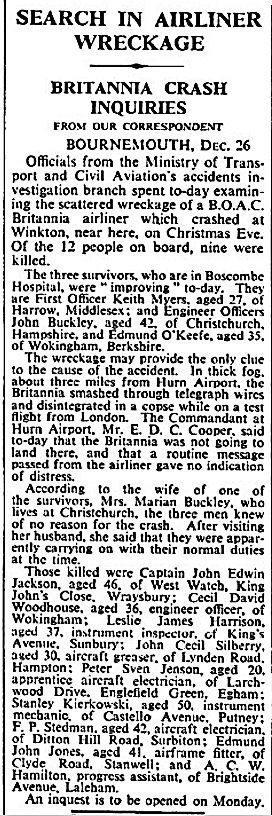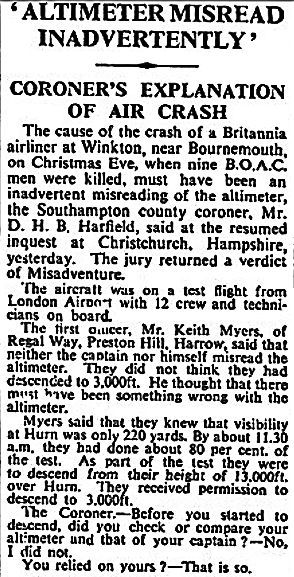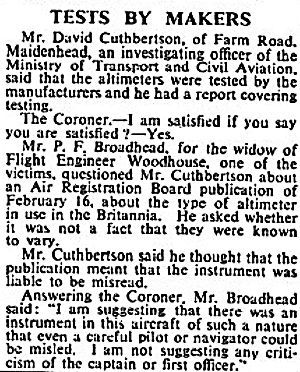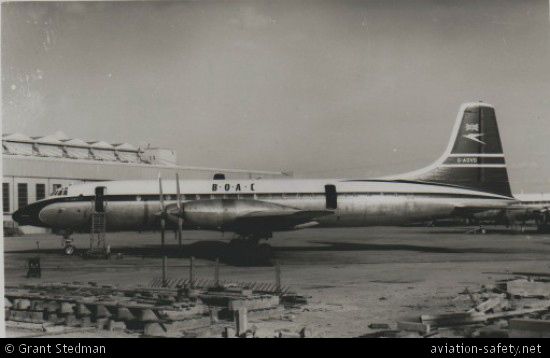Crash of BOAC Britannia G-AOVD 24.12.58
Thread Starter
Join Date: Aug 2000
Location: UK, sometimes USA
Posts: 402
Likes: 0
Received 0 Likes
on
0 Posts
Crash of BOAC Britannia G-AOVD 24.12.58
I've just been reading up on this crash which happened in my local area and have a few queries. Bear in mind I don't have sight of the offical accident report and it's not on the AIB website.
Recap: This Britannia was on a test flight (flight no. ?) and was attempting to land at Hurn (now Bournemouth) Airport in fog. The crash was attributed to an error in which the altimeter height was misread by 10,000ft.
Queries:
1) Why was it heading for Hurn when it was known to be affected by fog as well as Heathrow from where it departed? The BOAC maintenance facility at Hurn had long since departed so it can't be for that reason.
2) From it's crash location of Sopley park, now Moorlands College, it would appear to have been heading approx. NNW. over Burley Lane as it was apparently heading directly for Sopley School. I can't corroborate this though as I don't know what route the test flight took from Heathrow.
As this point is only about 3 miles from the runway 26 threshold, was it trying to join downwind for this runway? The alternatives could be it was heading for the 'HRN' beacon to join overhead before making an approach or that it was heading for nearby Ibsley reporting point to the north.
The reason the above is relevant is directly connected to the issue of height. The crew thought they were at 13,000ft when they requested descent to 3,000ft but were only 3 minutes from Sopley where they crashed. That means they were almost on top of their destination when they requested descent.
3)
Related to the above is what were ATC seeing? I'm not sure if the flight was under the control of Hurn or Ibsley but was there no transponder technology in 1958 that allowed ATC to see the Britannia's height? Regardless of their height, ATC had a flight very close to the airfield but, on the face of it, didn't seem to have a full picture of what was happening. Was this normal for ATC in 1958?
I'm not sure of the flight number for this accident but I'm sure posters will identify with this particular accident. Any information or a copy of the accident report would be gratefully received.
Recap: This Britannia was on a test flight (flight no. ?) and was attempting to land at Hurn (now Bournemouth) Airport in fog. The crash was attributed to an error in which the altimeter height was misread by 10,000ft.
Queries:
1) Why was it heading for Hurn when it was known to be affected by fog as well as Heathrow from where it departed? The BOAC maintenance facility at Hurn had long since departed so it can't be for that reason.
2) From it's crash location of Sopley park, now Moorlands College, it would appear to have been heading approx. NNW. over Burley Lane as it was apparently heading directly for Sopley School. I can't corroborate this though as I don't know what route the test flight took from Heathrow.
As this point is only about 3 miles from the runway 26 threshold, was it trying to join downwind for this runway? The alternatives could be it was heading for the 'HRN' beacon to join overhead before making an approach or that it was heading for nearby Ibsley reporting point to the north.
The reason the above is relevant is directly connected to the issue of height. The crew thought they were at 13,000ft when they requested descent to 3,000ft but were only 3 minutes from Sopley where they crashed. That means they were almost on top of their destination when they requested descent.
3)
Related to the above is what were ATC seeing? I'm not sure if the flight was under the control of Hurn or Ibsley but was there no transponder technology in 1958 that allowed ATC to see the Britannia's height? Regardless of their height, ATC had a flight very close to the airfield but, on the face of it, didn't seem to have a full picture of what was happening. Was this normal for ATC in 1958?
I'm not sure of the flight number for this accident but I'm sure posters will identify with this particular accident. Any information or a copy of the accident report would be gratefully received.
Join Date: Oct 2000
Location: Berkshire, UK
Age: 79
Posts: 8,268
Likes: 0
Received 0 Likes
on
0 Posts
<<ATC had a flight very close to the airfield but, on the face of it, didn't seem to have a full picture of what was happening. >>
Not sure what you mean by this as you have not provided sufficient information. In those days Hurn may not have had radar and would have depended almost entirely on pilot reports. If the aircraft was at 13000 ft was it in Controlled Airspace? If so, was it under the control of London Airways or London radar (from Sopley)?
Not sure what you mean by this as you have not provided sufficient information. In those days Hurn may not have had radar and would have depended almost entirely on pilot reports. If the aircraft was at 13000 ft was it in Controlled Airspace? If so, was it under the control of London Airways or London radar (from Sopley)?
Join Date: Aug 2006
Location: Timbukthree
Posts: 13
Likes: 0
Received 0 Likes
on
0 Posts
Height reading enroute and terminal radar was not available to civilian ATC facilities in 1958. Do not confuse it with GCA/PAR approaches.
An altimeter error of 10,000 ft. seems HUGE, and fairly screams at another system error as a contributing factor..
An altimeter error of 10,000 ft. seems HUGE, and fairly screams at another system error as a contributing factor..
Join Date: Jul 2003
Location: Cheshire, California, Geneva, and Paris
Age: 67
Posts: 867
Received 0 Likes
on
0 Posts
I seem to remember reading somewhere that altimeters at this time had a third small arrow which indicated 10,000s of feet.
This design of altimeter was re-engineered to remove the third small arrow because of accidents such as this due to mis-reading the altimeter.
This design of altimeter was re-engineered to remove the third small arrow because of accidents such as this due to mis-reading the altimeter.
This design of altimeter was re-engineered to remove the third small arrow because of accidents such as this due to mis-reading the altimeter.
bri,
Not an altimeter error, but a mis-reading by the crew. There were several crashes in the sixties attributable to mis-reading the "three-pointer" altimeter, including an Iberia Caravelle descending into Heathrow:
Iberia Airlines Flight 062 - Wikipedia, the free encyclopedia
Not an altimeter error, but a mis-reading by the crew. There were several crashes in the sixties attributable to mis-reading the "three-pointer" altimeter, including an Iberia Caravelle descending into Heathrow:
Iberia Airlines Flight 062 - Wikipedia, the free encyclopedia
Three pointers
Remeber our Trident union rep telling a story about a flight on the Comet when he was extra crew. Went up front when the gear went down to find them doing a heads down approach - rechecked the weather which showed 8/8ths at 10,000 ft.
Advised the crew of the mistake just before they performed a go around.
Skipper a well known speed merchant! RIP
Advised the crew of the mistake just before they performed a go around.
Skipper a well known speed merchant! RIP
Thread Starter
Join Date: Aug 2000
Location: UK, sometimes USA
Posts: 402
Likes: 0
Received 0 Likes
on
0 Posts
<<ATC had a flight very close to the airfield but, on the face of it, didn't seem to have a full picture of what was happening. >>
Not sure what you mean by this as you have not provided sufficient information. In those days Hurn may not have had radar and would have depended almost entirely on pilot reports. If the aircraft was at 13000 ft was it in Controlled Airspace? If so, was it under the control of London Airways or London radar (from Sopley)?
Not sure what you mean by this as you have not provided sufficient information. In those days Hurn may not have had radar and would have depended almost entirely on pilot reports. If the aircraft was at 13000 ft was it in Controlled Airspace? If so, was it under the control of London Airways or London radar (from Sopley)?
BTW: I remember now that Ibsley was only a reporting point/beacon at the time and the London Control was carried out by the former RAF Sopley site.
Evansb - thanks for the information about available ATC systems at the time. However, as the College of ATC was located at Hurn I wonder if they did indeed benefit from radar and other enhanced facilities due to college flying activities locally?
Join Date: Oct 2000
Location: Berkshire, UK
Age: 79
Posts: 8,268
Likes: 0
Received 0 Likes
on
0 Posts
<<the London Control was carried out by the former RAF Sopley site. >>
Control was exercised by London Airways from the Southern ATC Centre at Heathrow and Sopley was an outstation. In those days, procedural control was in the hands of the controllers at SATCC who could call upon the radar controllers at Sopley when needed. (Maybe some older hands could expand on this please?)
I'm not sure when the College of ATC started but when I did my course in 1971 the College used the Hurn Airport radar and the only flying associated with the College was by the Ministry of Aviation Doves used for ATC radar training.
HTH
Control was exercised by London Airways from the Southern ATC Centre at Heathrow and Sopley was an outstation. In those days, procedural control was in the hands of the controllers at SATCC who could call upon the radar controllers at Sopley when needed. (Maybe some older hands could expand on this please?)
I'm not sure when the College of ATC started but when I did my course in 1971 the College used the Hurn Airport radar and the only flying associated with the College was by the Ministry of Aviation Doves used for ATC radar training.
HTH
Sopley was originally an air defence radar unit like Ash and Wartlling. I don't know when civilian radar controllers started operating there, but I would guess it would be post 1960, well after this accident. In any case, the radar at Sopley was a Type 80, non MTI but with a 'blank' overhead (to cut out ground returns) which would have certainly covered Hurn. Sopley did have height-finder radars but these would only have scanned what the controller asked for, not every aircraft in the area.
Ibsley was closed as an airfield sometime in the late '40s I think.
Ibsley was closed as an airfield sometime in the late '40s I think.
Last edited by chevvron; 28th Feb 2013 at 11:04.
I remember reading a book on air accidents borrowed from public library during my teens. Memory/googling suggest it was 'Aircrash Detective' by Stephen Barlay. Written in mid/late sixties and covered post war accidents including the Comet going on to deep stall issues with early t-tails and the approach and landing accidents/incidents with 727 immediately after introduction to service.
Fairly sure it included a section on three pointer altimeters and the risk of 10k misreads, probably quoting this accident.
EDIT: The Wiki page on the IB Caravelle crash also refers to an accident in the US involving a United 727 which crashed into Lake Michigan in 1965. That too was attributed to mistake with 3pointer altimeters. It in turn links to a page on the Britannia accdient mentioned in the OP.
United Airlines Flight 389 - Wikipedia, the free encyclopedia
1958 Bristol Britannia 312 crash - Wikipedia, the free encyclopedia
The UA page also adds more data on tests carried out to explore reasons for altimeter misreads.
Fairly sure it included a section on three pointer altimeters and the risk of 10k misreads, probably quoting this accident.
EDIT: The Wiki page on the IB Caravelle crash also refers to an accident in the US involving a United 727 which crashed into Lake Michigan in 1965. That too was attributed to mistake with 3pointer altimeters. It in turn links to a page on the Britannia accdient mentioned in the OP.
United Airlines Flight 389 - Wikipedia, the free encyclopedia
1958 Bristol Britannia 312 crash - Wikipedia, the free encyclopedia
The UA page also adds more data on tests carried out to explore reasons for altimeter misreads.
Last edited by Airbanda; 28th Feb 2013 at 11:33.
Thread Starter
Join Date: Aug 2000
Location: UK, sometimes USA
Posts: 402
Likes: 0
Received 0 Likes
on
0 Posts
Sopley ATC was operational 1959-1974. The 'school' of ATC started in 1949 at Hurn then became a college in 1962. Sadly empty now I think.
Ah, the CAA Doves. The little blighters used to bomb over my home all day long but I miss them now!
Good stuff on the history of ATC. Maybe we need an ATC Nostalgia forum for aerodrome and airways of old conversations?
Ah, the CAA Doves. The little blighters used to bomb over my home all day long but I miss them now!
Good stuff on the history of ATC. Maybe we need an ATC Nostalgia forum for aerodrome and airways of old conversations?
As I said, Sopley was originally a fighter control unit from the early/mid 50s rather than ATC, the radar being unsuited for airfield work but suitable for area work. I'm not sure when the civil element started there but obviously it was not 1958!
There was a 'joint' area radar training school (ie training both civil and military controllers)at Sopley until the late '60s.
Going back to the College of ATC at Hurn, the Doves were controlled by students and instructors using consols in Bournemouth Tower alongside the 'regular' controllers, the college never had its own radar..
There was a 'joint' area radar training school (ie training both civil and military controllers)at Sopley until the late '60s.
Going back to the College of ATC at Hurn, the Doves were controlled by students and instructors using consols in Bournemouth Tower alongside the 'regular' controllers, the college never had its own radar..
Some times I wonder how peoples brains work. We have a discussion on two/three pointer altimeters and the jist seems to be that it is the three pointer altimeter that can instigate erronious readings.
Let us recap:
A two pointer has two needles. One does a complete rotataion every thousand feet and the other, smaller, does a rotation every ten thousand feet.
Therefore, at Zero, ten thousand, twenty thousand, etc both needles are at the Zero point. By definition, if you put somebody in a cockpit without external references he will be unable to ascertain his correct altitude within ten thousand feet.
This is why in the early days of jet aircraft pilots were losing track of their rate of descent and were splashing into the ground when they thought they had stacks of height; occasions often confirmed by radio calls.
Come the three needle altimeter. This has a needle that tells you your ten thousand foot increments so the alimeter can NEVER be ambiguous. Despite this pilots were still flying into the ground because when things go wrong even the blindingly obvious gets ignored.
Come the barber's pole. This is a striped area that shows on the face at around 17,000 ft in the descent. This lasted for a few years and then came the rotating number job with just one needle. That seems to he solved the problem.
There are still two needle altimeters in common use; they read in metres. I have flown many hours with those in China as with Russia it was the reference measurement. Very easy to maintain a reasonable height and paired with an ASI calibrated in Kilometers incredibly fast.
Let us recap:
A two pointer has two needles. One does a complete rotataion every thousand feet and the other, smaller, does a rotation every ten thousand feet.
Therefore, at Zero, ten thousand, twenty thousand, etc both needles are at the Zero point. By definition, if you put somebody in a cockpit without external references he will be unable to ascertain his correct altitude within ten thousand feet.
This is why in the early days of jet aircraft pilots were losing track of their rate of descent and were splashing into the ground when they thought they had stacks of height; occasions often confirmed by radio calls.
Come the three needle altimeter. This has a needle that tells you your ten thousand foot increments so the alimeter can NEVER be ambiguous. Despite this pilots were still flying into the ground because when things go wrong even the blindingly obvious gets ignored.
Come the barber's pole. This is a striped area that shows on the face at around 17,000 ft in the descent. This lasted for a few years and then came the rotating number job with just one needle. That seems to he solved the problem.
There are still two needle altimeters in common use; they read in metres. I have flown many hours with those in China as with Russia it was the reference measurement. Very easy to maintain a reasonable height and paired with an ASI calibrated in Kilometers incredibly fast.
Join Date: Nov 2007
Location: Waters edge
Posts: 446
Likes: 0
Received 0 Likes
on
0 Posts
It's all here
You will find an interesting account of the Britannia crash and circumstances here:
The Winkton Tragedy. By John Peaty | Christchurch History Society
Worth a read!
FF
The Winkton Tragedy. By John Peaty | Christchurch History Society
Worth a read!
FF
Some times I wonder how peoples brains work. We have a discussion on two/three pointer altimeters and the jist seems to be that it is the three pointer altimeter that can instigate erronious readings.
It would seem that investigations, both following accidents and in research discovered that the 3 pointer, in solving one issue, caused it's own problems. It was not, in practice, intuitive to read.
People's brains don't always work as the experts predict.
By the time of the Britannia, SE210, and 727 crashes referenced in this thread the alternative was presumably the drum or odometer type rather than reversion to the two pointer.
Last edited by Airbanda; 1st Mar 2013 at 12:14.
Join Date: Aug 2007
Location: Under the downwind leg
Age: 87
Posts: 8
Likes: 0
Received 0 Likes
on
0 Posts
I completed my RN apprentiship in 1957 and recall during the Instruments phase that it was explained that a civil accident had occurred when the 10000 ft needle was hidden behind the 1000 ft needle.
The solution was to place a circular ring on the 10000 ft needle that could be seen when the needles overlapped, which became standard on RN aircraft.
I believe the Scimitar was the first FAA aircraft to have the cross hatch window in the altimeter.
The solution was to place a circular ring on the 10000 ft needle that could be seen when the needles overlapped, which became standard on RN aircraft.
I believe the Scimitar was the first FAA aircraft to have the cross hatch window in the altimeter.







